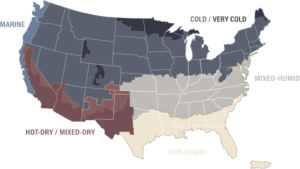No matter which country or city you live in, having proper insulation in place is the key to making your home more comfortable and energy-efficient.
Heat is constantly traveling. During the summer, heat flows inside the home while, during the winter, heat flows out of the home. However, a home that is properly insulated is successful in reducing that heat flow, thus saving money and energy.
Heat Transfers
You may be surprised to learn that heat transfer can greatly sabotage a house’s energy efficiency. That said, how does this happen and is there anything you can do to stop it?
Heat transfer can happen in one of three ways: radiation, convection, or conduction.
Radiation occurs when heat moves from a hot substance onto a cooler one. For example, a house with black roofing material has a greater likelihood of attracting heat and this same heat will transfer into the attic.
Convection occurs when moisture and heat move; this can happen when the envelops (walls, sheathing, siding) are loose. However, many convection problems can be solved by sealing your home with spray-foam insulation.
Conduction is the transfer of heat by means of a material. Conduction is greatly affected by the material’s R-value, the measurement of thermal resistance or, in other words, the capacity to stop the transfer of heat. While a higher R-value is essential for providing a thermal barrier, it doesn’t address radiation or convection. A house can only reach its highest energy-efficiency by improving insulation, air-sealing the room, and paying attention to the radiant heat from the roof.
The Importance of R-Values in Energy Efficiency
Think of R-value this way: Say you were to take a candle and hover a piece of paper above it. The paper would get warm rather quickly and you’d be able to feel this heat on the paper’s opposite side. However, say you were to take this same candle but, instead, hover a brick overtop of the flame. True, the side closest to the flame would warm up, but you would not be able to feel the warmth on its opposite site as quickly as with the paper. In this, the brick demonstrates a higher R-value in comparison to the piece of paper.
The larger the R-value, the more difficult it becomes for the insulation to stop heat conduction.

Climates across the United States vary widely. Depending on where you live, the question now is how much R-value is adequate and what’s considered to be energy efficient? The bulk of houses built in the Mid-Atlantic have inadequate roof insulation, as modern standards call for roofs with R-30 or R-40.
What does that mean, practically? If you peek in your attic and can see wooden rafters, you don’t have enough insulation.
Improving Your R-value
Despite other existing air-sealing methods, insulation is the best way to enhance your home’s R-value and energy conservation efforts. However, you need to think beyond just the R-value. As you work towards preventing heat transfer of any variety and search for ways to tighten your home, also make an effort to improve your building envelop with better roofing and secure siding (prevents radiation and convection).
Remain mindful when selecting your insulation material. The most common varieties of insulation material are foam board, cellulose (paper fiber), and fiberglass batting. Foam board will supply you with higher R-values, but at a slightly higher cost.
Last, always target for high standards. Broadly speaking, walls should be R-19 along with the roof being R-30 or R-40, according to Wilson. However, you can go a bit higher by following the standards put forth by the Passive House Institute US, which is R-30 walls and an R-60 roof.
Interested in improving your home’s R-value? Give us a call today at (443) 459-5800 and let our team help you save money and energy!


